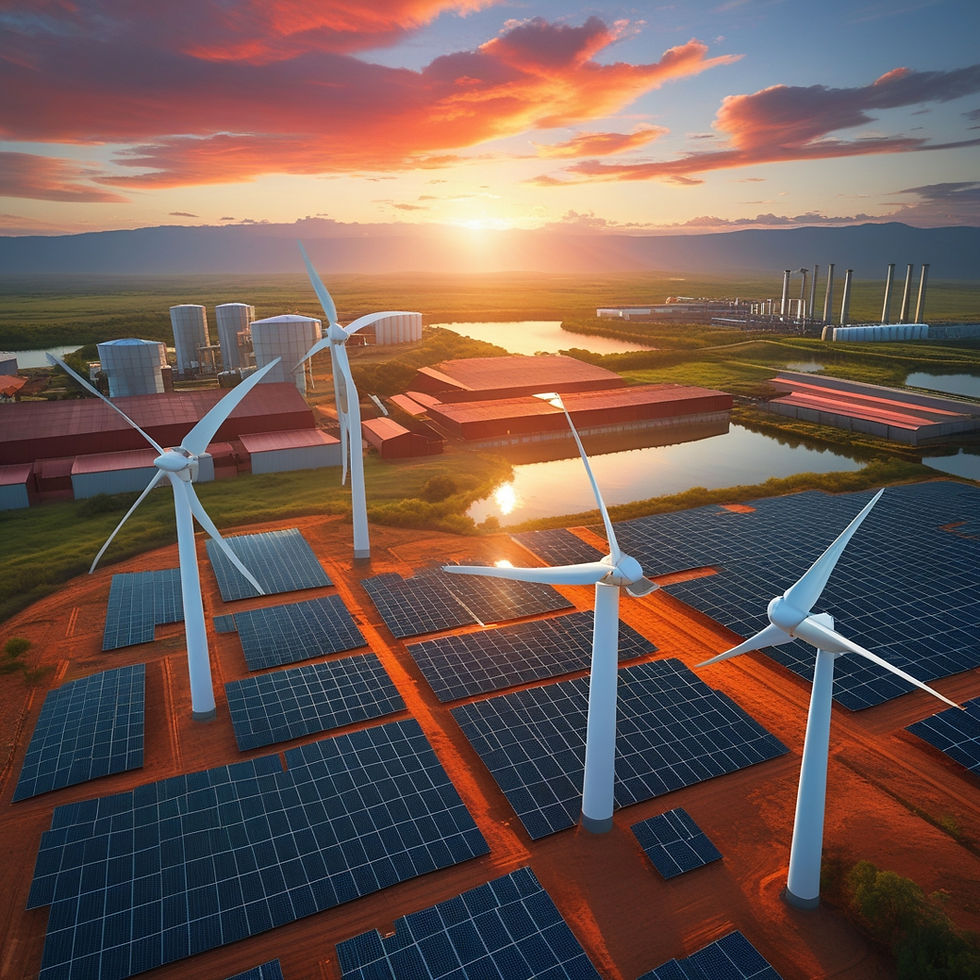🌎 Green Trade and Industry: Renewable Energy in the Americas on the Rise
- Antonio Carlos Faustino

- Jul 1
- 4 min read

Introduction
Renewable energy in the Americas is moving from a trend to a cornerstone of commercial and industrial strategies . Countries and companies that invest in clean and sustainable solutions are already reaping the benefits in the form of cost reductions, access to international markets and ESG reputation .
As climate urgency accelerates, the continent’s energy revolution is driving sectors such as the free energy market, industrial solar energy and carbon credits . This article shows how this shift directly impacts trade, industry and investors, providing up-to-date data, practical examples and real monetization opportunities.
The New Energy Map of the Americas
The continent’s diverse resources are a competitive advantage. The sun of Atacama , the wind of Patagonia , the hydroelectric potential of Brazil , the advance of green hydrogen in the US — all make up a robust and strategic energy ecosystem.
The International Renewable Energy Agency (IRENA, 2024) states that more than 27% of the continental energy matrix is renewable. This percentage increases with tax incentives, international sustainability requirements and the search for ESG certification in supply chains.
Why do Industries and Commerce Bet on Clean Energy?
1. Reduction of operating costs
Companies that use industrial solar energy report a reduction of up to 80% in their energy bills. One example is Codelco (Chile), which replaced part of its energy with solar photovoltaic energy, maintaining its competitiveness in the mining sector.
2. Access to demanding markets
Exporters who demonstrate their use of clean energy and carbon neutrality are given preference in trade agreements with the US and EU . Energy traceability has already become a criterion for selecting suppliers.
3. Green credit lines
Financing for renewable energy , whether through BNDES, IDB or international climate funds, is growing. Specific lines are available for industrial projects, small plants and free market energy infrastructure .
Success Stories in Energy Transition
🇧🇷 Brazil: power in clean energy
With 85% of the electricity matrix clean , Brazil leads with:
Hydroelectric plants such as Itaipu;
Expansion of the free energy market ;
Incentives for industrial and rural solar energy;
Leadership in biofuels and carbon credits .
Programs such as RenovaBio and the I-REC Certificate attract investors and reduce emissions with international proof.
🇨🇱 Chile: the sun at the service of innovation
The Cerro Dominador plant , with solar thermal technology, is a pioneer. With a high irradiation rate, the country is betting on green hydrogen for export by 2030, attracting large multinationals.
🇺🇸 USA: Incentive-led transition
The Inflation Reduction Act (IRA) freed up billions of dollars to:
Expansion of offshore wind energy;
Incentives for green startups and green hydrogen ;
Construction of factories with 100% clean energy ;
Mandatory ESG certifications in public tenders.
Persistent Challenges
Lack of integrated energy infrastructure in Central America;
Dependence on fossil fuels in countries such as Venezuela and Bolivia;
Shortage of qualified technical labor ;
Low adherence to ESG in small and medium-sized industries.
Sustainable Paths
Green production zones with tax incentives and use of industrial solar energy;
Adoption of microgeneration systems and smart batteries ;
Expansion of technical education with a focus on energy transition;
Encouraging the tokenization of carbon credits via blockchain.
Recommended Products and Infoproducts (Affiliates)
🛒 Amazon (affiliate):
📗 Book “ Investment analysis in photovoltaic solar energy projects ”
⚡ EcoFlow Portable Battery – Ideal for Sustainable Industries
🎓 Hotmart:
💡 Professional Solar Energy Course – Design and Installation
Useful links
Conclusion
Renewable energy in the Americas is becoming a competitive differentiator in commerce and industry. More than an environmental requirement, it is a new economic model: profitable, resilient and globally respected .
The energy transition is underway — and those who fall behind will lose more than energy: they will lose market share.
💚 Did you like the content? Value independent and intelligent content! Support Bom dia América with one click:👉 Support now
📚 References
INTERNATIONAL RENEWABLE ENERGY AGENCY (IRENA). Renewable Energy Statistics 2024 . Abu Dhabi: IRENA, 2024. Available at: https://www.irena.org . Accessed: July 1, 2025.
INTER-AMERICAN DEVELOPMENT BANK (IDB). Green Jobs in Latin America and the Caribbean: Opportunities with the Energy Transition . Washington, DC: IDB, 2024. Available at: https://www.iadb.org . Accessed: July 1, 2025.
BRAZIL. MINISTRY OF MINES AND ENERGY. National Energy Balance 2024 . Brasília: MME/EPE, 2024. Available at: https://www.gov.br/mme/pt-br . Accessed on: July 1, 2025.
CODELCO – National Copper Corporation of Chile. Sustainability and Clean Energy . Santiago, 2024. Available at:https://www.codelco.com . Accessed on: 01 Jul. 2025.
CHILE. MINISTRY OF ENERGY. National Energy Plan 2023–2030 . Santiago: Government of Chile, 2023. Available at: https://energia.gob.cl . Accessed: July 1, 2025.
UNITED STATES. US DEPARTMENT OF ENERGY. Clean Energy Investment Report: IRA Progress 2024 . Washington, DC, 2024. Available at: https://www.energy.gov . Accessed on: 01 Jul. 2025.
CLIMATE BONDS INITIATIVE. Green Bonds Market Summary Q1 2025 . London: Climate Bonds, 2025. Available at: https://www.climatebonds.net . Accessed on: July 1, 2025.
GOMES, Mariana. Energy transition and the role of the private sector in the Americas . Brazilian Journal of Renewable Energy, São Paulo, v. 18, n. 2, p. 45-62, Apr./Jun. 2024. Available at: https://revistas.energiasustentavel.org . Accessed on: Jul. 1, 2025.




Comments